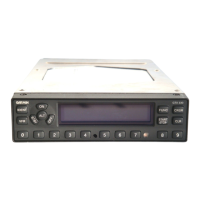190-00207-02 GTX 330/330D Installation Manual
Rev. U Page 5-3
5.1.2 Code Selection
Code selection is entered with eight keys (0 – 7) providing 4,096 active identification codes. Pushing one
of these keys begins the code selection sequence. The new code is not activated until the fourth digit is
entered. Pressing the CLR key moves the cursor back to the previous digit. Pressing the CLR key when
the cursor is on the first digit of the code, or pressing the CRSR key during code entry, removes the cursor
and cancels data entry, restoring the previous code. You may press the CLR key up to five seconds after
code entry is complete to return the cursor to the fourth digit. The numbers 8 and 9 are not used for code
entry, only for entering a Count Down time, contrast and display brightness, and data selection in the
Configuration mode.
The selected identification code should be entered carefully, either one assigned by air
traffic control for IFR flight or an applicable VFR transponder code.
• Important Codes:
1200 VFR code for any altitude in the US (Refer to ICAO standards elsewhere)
2000 VFR code commonly used in Europe (Refer to ICAO standards)
7000 VFR code commonly used in Europe (Refer to ICAO standards)
7500 Hijack code (Aircraft is subject to unlawful interference)
7600 Loss of communications
7700 Emergency
Avoid selecting code 7500 and all codes in the 7600-7777 range. These codes trigger special indicators in
automated facilities. An aircraft’s transponder code is used for ATC tracking purposes, therefore exercise
care when making routine code changes.

